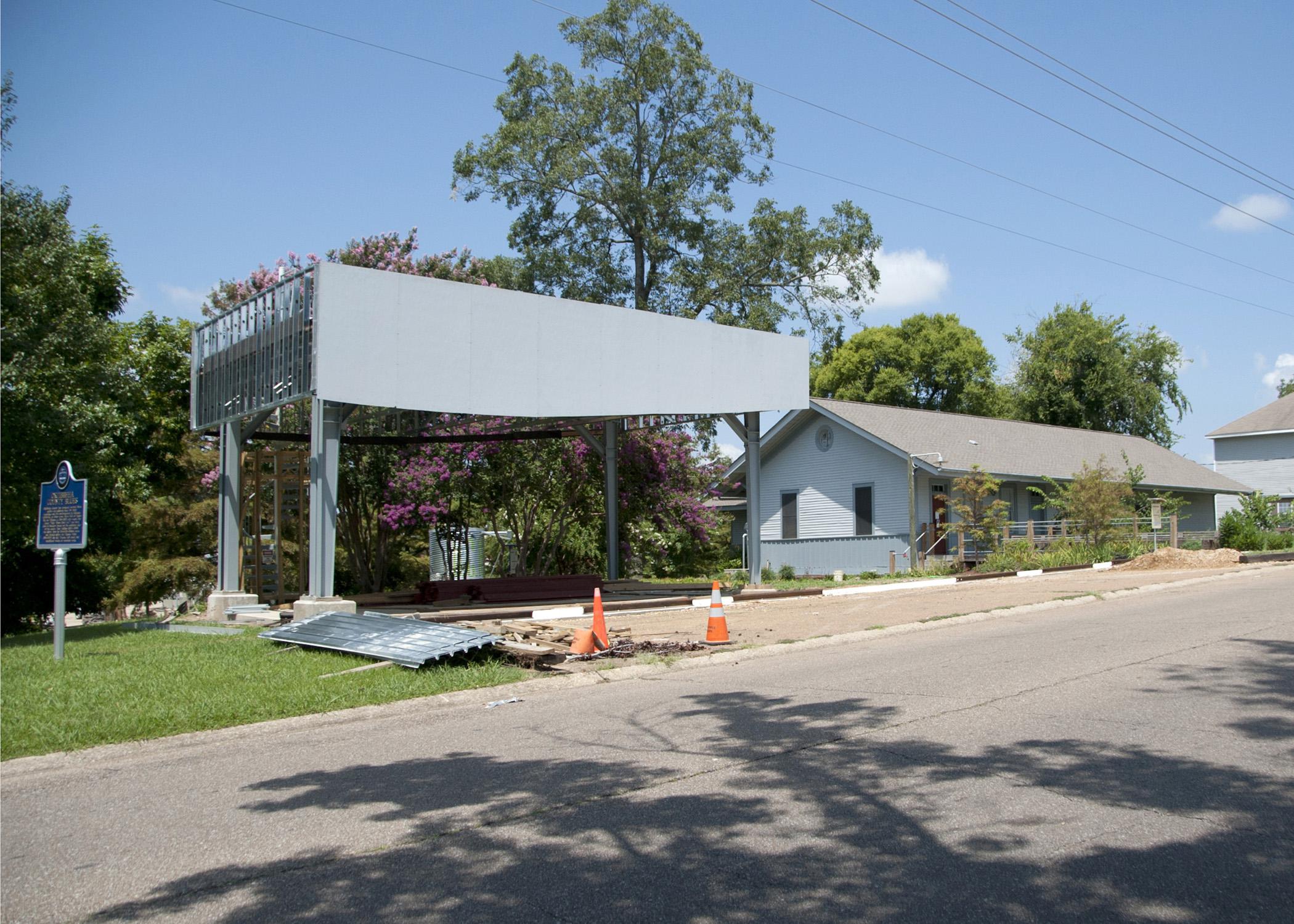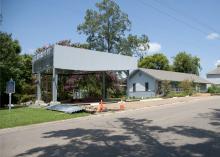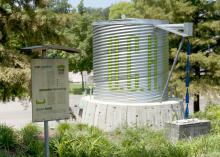Information Possibly Outdated
The information presented on this page was originally released on August 23, 2012. It may not be outdated, but please search our site for more current information. If you plan to quote or reference this information in a publication, please check with the Extension specialist or author before proceeding.
Museum gets style, shade from pavilion
STARKVILLE – A Mississippi museum is conserving the past inside and embracing the future outside with its modern, sustainable landscape.
Visitors to the Oktibbeha County Heritage Museum will enjoy a new pavilion’s shade but may not realize they are surrounded by environmentally friendly solutions to a challenging landscape using environmentally friendly solutions.
Cory Gallo, assistant professor in Mississippi State University’s Department of Landscape Architecture, and MSU architecture professor Hans Hermann led the design and construction of the pavilion. Students from various academic programs, including landscape architecture, landscape contracting, architecture, building construction and art built it throughout the summer. The structure incorporates repurposed materials, such as a spiral staircase from a church building in Memphis and awning materials from a restaurant in Starkville.
“We wanted to use sustainable materials as much as possible and install a green roof on the pavilion,” Gallo said. “Green roofs have been used in Europe and urban areas in the United States for years because they have a lot of benefits.”
A green roof is one covered with vegetation, usually add beauty and conserve energy.
“In addition to being more visually appealing when viewed from above, they help control storm water runoff by 30 to 50 percent, provide greater insulation, last two to three times longer than a traditional roof and provide habitat for nesting birds,” he said.
The components for the green roof were donated by Hydrotech.
“We don’t just put soil and seeds up on a regular roof,” Gallo said. “We start with a root barrier, then add a drain mat connected to the drainage system to move water not absorbed by the plants and soil. On top of the drain mat we put a filter fabric layer. Then we add soil and a sedum mix. Sedums are found in nature on hillsides and stone outcroppings; they are plants that typically require less soil and little water.”
The pavilion is the final project in a four-year series of “green technology” additions to the museum grounds.
“First we installed a rain garden, then a sand filter system and next an amphitheater, where they have movie nights,” Gallo said. “Phase 3 was a renovation of the porch and entry to the museum, and during Phase 4, we installed the water cistern and designed signs and information panels. We put pervious concrete in the parking lot and used some donated, abandoned railroad rails for parking wheel stops.”
Gallo said with the completion of the pavilion, the Oktibbeha County Heritage Museum will have one of the best collections of sustainable storm water strategies in the Southeast, which benefits the community and the students who did the work.
“They get practical experience in sustainable design practices and can see firsthand the positive impact their work can have,” he said. “They also experience a lot of pride -- the museum docents tell us students stop by with their families and friends to show them the projects.
“We’ve loved working with the community, but I’d like to bring that sense of pride back to the campus and develop some collaborative sustainability projects at MSU,” he said.
Joan Wilson, chair of the museum’s board of directors for eight years, could not be more thrilled with the difference these projects have made.
“It all started with a conversation about the terrible drainage problem we had under the museum,” she said. “Wayne Wilkerson fixed that problem with a system of filters and drains, then Cory jumped on board, and they’ve revolutionized the exterior of the museum.
“The students have had such talent -- they brought their ideas to us and we selected which designs we liked best, and then they constructed everything. We’ve never said, ‘No, you can’t do that!’ and now there’s as much to talk about outside the museum as there is inside,” she said.
Volunteer coordinator Diana Crabtree, who installed a dry creek at her house for water control after seeing its benefits at the museum, said the grounds are more visitor-friendly now.
“Scout groups come for tours and can eat outside, we’ve had three movie nights so far, and the museum is becoming more of a gathering place,” she said.
Museum volunteer Shirley Carley is pleased the landscape improvements have brought greater attention to the museum.
“The outdoor projects have brought people in out of curiosity, and we hope these sustainable ideas carry over into the community,” Carley said. “Our landscape is educational, challenging and beautiful.”





